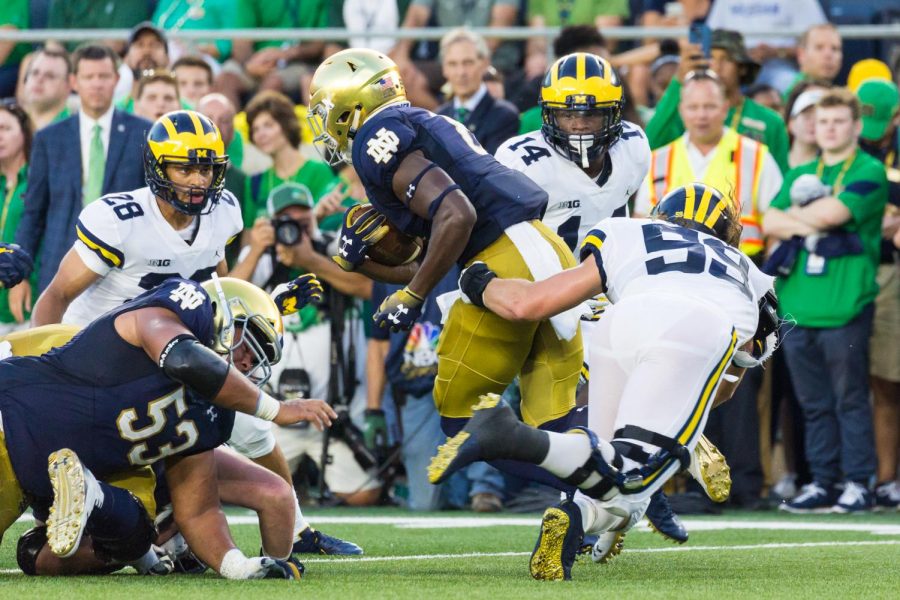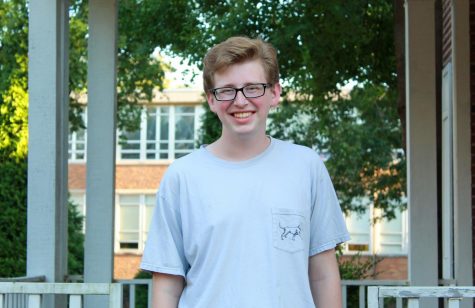The Timeout: The Return(?) of Football
The Michigan Wolverines (white jerseys) play in the Big 10, which has already canceled its season. Notre Dame (blue jerseys) play as independents, leading to numerous challenged with game cancelations.
August 17, 2020
Last week, I took a comparative peek at the responses of Major League Baseball and the National Basketball League to the COVID-19 pandemic. Though both leagues are wildly popular, two other leagues hold the top spot in the south: professional and college football. Like the leagues featured last week, they have taken their own approaches to returning to play with varying levels of support. Of the two, the governing body for college sports, the National Collegiate Athletic Association (NCAA), has yielded more variety than any other sport league, thanks primarily to its nature as an association of semi-independent conferences. Neither league’s season has begun yet, so all that can be done is speculate on just how effective their current plans may be.
NFL
Thus far, the National Football League (NFL) has been the least affected major sporting league. Thanks to the pandemic beginning in the middle of the offseason, only the draft and some practices have been altered. Similarly, the planned schedule has seen the least change. Currently, the league aims to play its season as originally scheduled, except for the now-canceled preseason games. That said, it does have contingency plans in case the regular season sees delays or postponed games. Whether these plans could accommodate a massive breakout in one team (à la the St. Louis Cardinals for the past few weeks) is not quite clear.
Not only is their operating plan largely unchanged, but many teams are considering and even planning games with fans in attendance, which none of the leagues currently playing allow. Current plans for these stadiums do not indicate how fans will be managed in the stadium. As for players and staff, the rules seem to generally resemble the rules Major League Baseball has. Teams are practicing in their own facilities and will travel to games, while there is no enforcement of social distancing or quarantining outside of the stadiums. For now, though, it seems to be working in the NFL. One key difference lies in mandatory COVID-19 testing. Everyone present in the league’s training camps is required to be tested daily, and the league has administered more than 100,000 tests to date. Their positivity rate is around 0.5%.
Perhaps these mandatory tests will restrict the spread of the virus better than the MLB did. I doubt that any fan presence will be managed safely, but I also suspect that many of these teams will change their tune on these plans. The season is not set to begin until Sept.10, so the league has plenty of time to develop plans. If I were in charge, I would keep an eye on the other leagues playing and take some detailed notes on what has gone right and what has gone wrong. The NFL is in a fantastic position to learn from the mistakes and successes of those who came before, and hopefully, it can continue its uncontroversial path so far.
NCAA
In the last few weeks, college football has taken many of the headlines of the sporting world. Since the NCAA governs dozens of college sports for hundreds of institutions, it has faced COVID-19 head-on since it first hit the United States. All the way back in March, it was among the first leagues to immediately cease activities when it canceled conference and league basketball tournaments. At that point, what would happen to college football was the least of our worries, and frankly, I doubt many even seriously considered the possibility of the pandemic truly affecting fall sports. Despite early questions, we now sit within a highly divided NCAA that cannot form any singular direction to face the forthcoming challenges.
The prime difficulty with formulating a plan for the NCAA is the simple fact that it is unlike any professional sports league. This is for good reason; it is not a professional league. Its players are college students. Amateurs. The people at risk here are not playing because it is their job but out of love for the game. They face questions of eligibility–will sitting out for safety or even canceling the year cause them to lose a year to play. The NCAA enforces strict rules on how long students can play. Meanwhile, the schools and conferences must balance their own desires with the goal of maintaining the health and safety of their players as well as upholding the expectations of their boosters. In many cases, especially among the largest schools, college football is the cash cow, funding the entirety of the school’s athletic budget. For the schools, playing is as much about money as anything else.
The debates on what shape the season will take have directly contributed to some more existential debates on college football. Amid the release of plans for abbreviated football schedules, a group of Pac-12 players sent a letter to the conference demanding a variety of rights and guarantees of safety. During prior debates and activities, exact plans for ensuring the safety of players had been closely guarded. Several administrators even expressed disdain toward enacting further protocols to player protection, instead insisting they just deal with the pandemic. The demands of these Pac-12 players have also fallen into the calls for compensation to the players. Some nine months ago, the NCAA released its initial blueprint for the regulation of name, image and likeness compensation. Now as players face the possibility of an even greater health risk, they join the calls to be able to receive some form of compensation.
Since conferences began announcing plans for the fall back in June, nearly every week has seen a different set of responses. From full steam ahead to conference-only to spring football to nothing at all. Just this past week, the Pac-12 and Big 10, two Power 5 conferences, which are the five most powerful and prestigious of the NCAA, announced their plans for a spring football season. The other three Power 5 all still intend to play this fall in abbreviated conference-only schedules, with many of their schools still trying to offer opportunities to attend games in person in the fall.
I absolutely love college football. It might be my favorite sport to watch. I miss it, and I’m ready for it to return. Despite my love for the sport, I find it hard to support the conferences that aim to continue with little restriction or alteration. Both major Mississippi universities play in the SEC, and they will be on the field in late September should nothing change. I find this terrifying for those student athletes. If not for the money the colleges expect to receive this fall, they would more than likely have no intention of playing. However, they think their income matters more than the lives of the students they are charged with protecting. There is still plenty of time for the rest of the major conferences to alter their plans, and I hope they do so, for the sake of students and athletes across the country.









